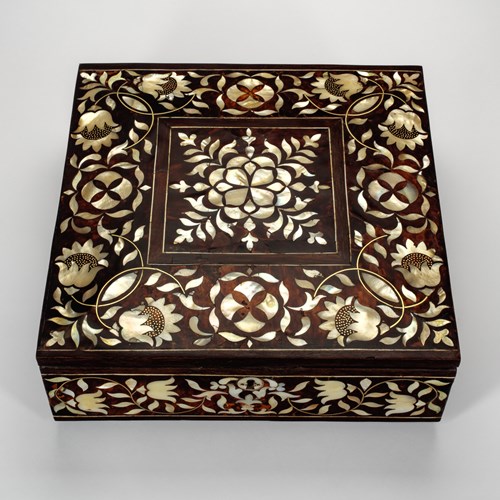A Lady Smokes a Huqqa Amongst her Attendants
Date Late 18th century
Period 1750-1850, 18th century
Origin India, Mughal, Murshidabad
Dimension 26 x 19.5 cm (10¹/₄ x 7⁵/₈ inches)
A lady reclines on a white terrace, sitting on a gold chair, inlaid with green and magenta precious stones, and holds the tip of the huqqa pipe in front of her lips. She has long black tresses and arched eyebrows. She wears gold churidar pai-jama trousers, decorated with blue flowers, a lilac top, pearls and an alluring gold hat with a black feather. Female attendants stand behind her, holding gold bejewelled perfume bottles and boxes. They are dressed in patterned turquoise, peach and golden churidar pai-jama trousers, semi-transparent saris and headdresses.
Although the scene’s overall white palette seems to echo the imperial Mughal style, the artist’s liberal use of gold blends beautifully with the ivory terrace. This style of painting is associated with the 18th century Murshidabad Court in north eastern India (Losty, p. 83). The landscape further suggests its connection to Murshidabad; a greyscale valley recedes towards a flat horizon lined with trees, creating the illusion of a three dimensional space. This seems intended to imitate reality, observable from the viewer’s eye level, which is characteristic of European art since the Renaissance.
It is possible that the artist had studied landscape paintings from Europe. In 1750 there was a discovery of an Italianate landscape study by an unknown artist, either from Bengal or Avadh (Losty, pp. 34-55, fig. 9). The composition of a portrait on a terrace was popular in Murshidabad painting (Losty, p. 83). The San Diego Museum of Art, California, houses a painting where the ruler Nawab Mir Ja’far is shown smoking amongst his male attendants (Accession Number 1990.428). The horizon is flat with a seemingly shared artistic comprehension of depicting perspective. The Victoria and Albert Museum, London, also has two paintings attributed to late 18th century, both depicting lavish men and women smoking on an ivory terrace (Accession Numbers D.1178-1903 and D.118-1903). During this time, women of the harem smoked in palaces and homes of the rich (Habighorst et al, p. 48). The penchant for smoking, along with the formal affinities to Murshidabad painting, suggests this work may be attributed to the late 18th century.
Stock no.: A4553
Date: Late 18th century
Period: 1750-1850, 18th century
Origin: India, Mughal, Murshidabad
Dimension: 26 x 19.5 cm (10¹/₄ x 7⁵/₈ inches)
Provenance: Private European Collection, exhibited in Paris, 1973
Literature: Habighorst, L.V. et al. Love for Pleasure: Betel, Tobacco, Wine and Drugs in Indian Miniatures, Germany, Ragaputra Editions, 2007.
Losty, J.P. ‘Towards a New Naturalism: Portraiture in Murshidabad and Vadh 1750-1800’, in B. Schmidtz (ed.), After the Great Mughals: Painting in Delhi and the Regional Courts in the 18th and 19th centuries, Bombay, 2002, pp. 34-55.
Losty, J.P. ‘Painting at Murshidabad 1750-1820’, in, N. Das and R. Lleewllyn-Jones, (eds.), Murshidabad: Forgotten Capital of Bengal, Mumbai, Marg, 2013, pp. 82-105.
More artworks from the Gallery







_T638772014586673341.jpg?width=500&height=500&mode=pad&scale=both&qlt=90&format=jpg)

